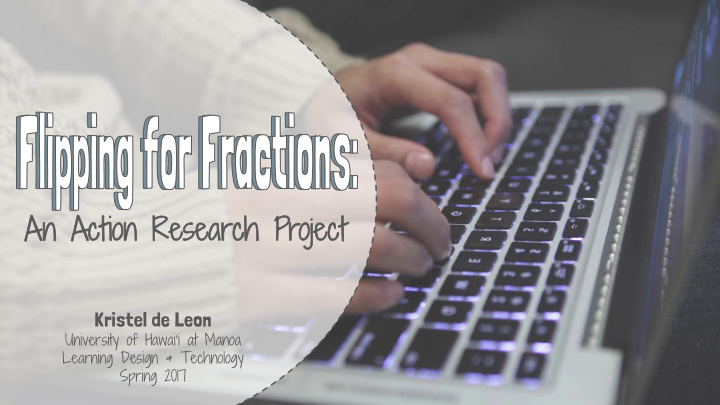



An A Actio ion R Research P Project Kristel de Leon University of Hawai’i at Manoa Learning Design & Technology Spring 2017
About Me ● 5 th grade teacher on Maui ● University of Hawai’i at Manoa LTEC Masters candidate ● Interested in innovative teaching methods
Audience Poll #1 Do you remember learning about fractions using the traditional lecture model? A. Yes B. No C. I don’t remember.
Agenda Bac Backg kgrou ound nd
Agenda Proj Project ect Bac Backg kgrou ound nd Develo lopme ment
Agenda Dis iscussio ion Proj Project ect Bac Backg kgrou ound nd + + Develo lopme ment Conclu lusio ion
Ba Background
Rationale • Operations involving fractions a consistent concern • Low class average • Lack of student engagement and low retention of skills • Critical concept beyond 5 th grade
Rationale
Rationale
• Actio ion Research esearch: Solution - Iterative process - Identify problem - Technology-related intervention
Solution • Constructiv ivis ist T Theory: y: - Create+make use of knowledge - Relies on collaboration - Relevancy to real life - Enriched by technology
Purpose Statement To evaluate the impact of a flipped classroom model using the Interactive Video Learning Platform (IVLP), PlayPosit, on engagement and retention of skills on fifth grade students’ unit of study on multiplying fractions at a public elementary school in Maui, Hawai’i.
Research Questions • Impact of a flipped classroom on ability to learn math content? • How engaged are students when using interactive videos? • How engaged are students when collaborating on problem solving tasks in class compared to traditional learning?
Develo lopment
What is the flipped classroom?
Traditional Model Lec Lectures es
Traditional Model Lec Lectures es
Traditional Model Lec Lectures es 136 136 Home mework a activ ivit itie ies
Traditional Model Lec Lectures es 136 136 Home mework a activ ivit itie ies
Flipped Model 136
Flipped Model lectures line le Onlin 136
Flipped Model lectures line le Onlin 136
Flipped Model lectures line le Onlin Cla lass a activ ivit itie 136 ies
Benefits ● Focus is on the student ● Learner-generated environment ● Differentiation instruction
Design Elements P art 1 1: C CURRICULUM P art 2 P art 3
Content ● Common Core State Standards ● Origo Stepping Stones
Concepts • multiply whole numbers by common fractions and mixed numbers
Concepts • multiply whole numbers by common fractions and mixed numbers • multiply fractions by fractions
Concepts • multiply whole numbers by common fractions and mixed numbers • multiply fractions by fractions • represent multiplication of fractions through visual models
Concepts • multiply whole numbers by common fractions and mixed numbers • multiply fractions by fractions • represent multiplication of fractions through visual models • solve word problems involving mixed numbers
Design Elements P art 1: Curriculum P art 2 2: T TECHNOLOGY P art 3
Tech Planning • Readily available+original videos • 9 total lessons • Assigned as nightly homework
Tech Tools: Video Creation + Recording
Google Slides
Google Slides
Google Slides
Doceri iPad App
Doceri iPad App
Doceri iPad App
Tech Tools: Interactive Video Learning Platform
PlayPosit Lin ink t to a an e exis istin ing vid ideo o or u uplo load yo your own. own.
PlayPosit Link to an existing video or upload your own. Add q questio ions a as specif ific ic t tim imed in intervals ls.
PlayPosit PlayPosit Insert a a m multip iple le Link to an existing choic ice q questio ion. video or upload your own. Add questions as specific timed intervals.
PlayPosit Insert a multiple Link to an existing choice question. video or upload your own. Insert a a f free Add questions as response q questio ion. specific timed intervals.
Instant Feedback
Instant Feedback
Class Activities
Zero le lectures Class Student-le led Activities Dyn ynamic mic le learnin ing
Design Elements P art 1: Curriculum P art 2: Technology P art 3 3: D DA TA C COLLECTION
Data Collection ● Formative data
Data Collection ● Formative data
Data Collection ● Formative data
Data Collection ● Formative data
Data Collection ● Formative data ● Observation protocol
Data Collection ● Formative data ● Observation protocol
Data Collection ● Formative data ● Observation protocol
Data Collection ● Formative data ● Observation protocol
Data Collection ● Formative data ● Observation protocol
Data Collection ● Formative data ● Observation protocol ● Post-module questionnaire
+ Conclu lusio ion
Lessons Learned • Test technology early • Include more examples • Valuable experience in Web 2.0 tools
Pointers Start small • Use a script • Experiment freely • Welcome feedback and • adjust accordingly
Future Plans Create more original content • Upgrade to a premium version of • PlayPosit Apply concept across other modules • and content areas
Thank You! • Critical Friends: Jami, Robin, and Marie • LTEC ‘Ohana: - Dr. Lin, Dr. Ho, and Dr. Fulford - Lei, Pam, and Angela • My support system: family and friends
Questions? ontact Me: ct Me: kpdeleon@hawaii.edu Cont
An A Actio ion R Research S Study y Kristel de Leon University of Hawai’i at Manoa Learning Design & Technology Spring 2017
Recommend
More recommend